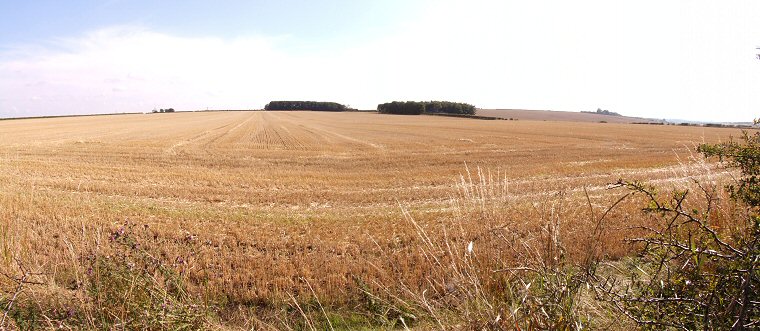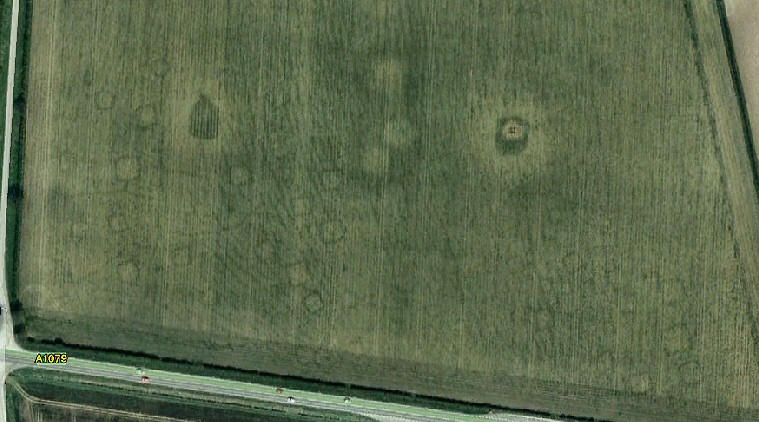As can be seen
from the 180 degree panorama above, there is sadly nothing to be seen
on the ground at this Iron
Age barrow cemetery although it once contained over one hundred square barrows
- this wide angled view (scroll to the right to see full image) shows
the northern section of the site that stands immediately to the north
of the A1079 road. The finds in this area of East Yorkshire have been
termed 'Arras Culture' and are thought to date from around 400-200BC and
it is possible that they may be the burials of the Celtic Parisi tribe
who had links with, and may have originated from, Northern France.
Originally the barrow mounds were around 1 metre in height and up to 9 metres in diameter, some were contained within square enclosures between 9 and 12 metres wide, with a 1 metre deep and 2 metre wide ditch. It is the shape of these enclosures that give the barrows their distinctive forms and hence their 'square barrow' title. Interestingly there where also several earlier Bronze Age round barrows nearby that suggest the area already had a long history as a focus for ritual activity.
Much of the site was excavated between 1815-1817 by the Rev E W Stillingfleet and all of the excavated mounds contained a single burial, mostly laid on their side in a crouched position and with the heads pointing either to the north or south. Most only contained a few personal possessions such as bronze and jet rings, bronze armlets and penannular brooches but four mounds contained much richer grave goods - these have been named King's Barrow, Queen's Barrow, Lady's Barrow and Charioteer's Barrow.
King's Barrow - contained a body of an old man surrounded by the remains of a two wheeled chariot or cart. The wooden frame of the cart had long since rotted away but the iron tyres and nave hoops (the strengthening bands around the wheel hub) were still intact along with the linch pins that would have held the wheel onto the wooden axle. Beneath each wheel were the skeletons of a horse, presumably to provide traction for the chariot and its owner into the next life, the man would not go hungry either - the skulls of two pigs where also found in the grave.
Queen's Barrow - the female buried in this mound was found wearing a glass necklace consisting of nearly 100 blue and white beads along with a pair of bronze armlets, bronze pin and tweezers, amber and gold rings and a bronze brooch and pendent inlaid with white coral.
Lady's Barrow - this female was buried with a iron mirror (see Celtic mirror for a similar example) and also the remains of another cart similar to that in the King's Barrow.
Charioteer's Barrow - as the name implies, this also contained a cart/chariot, as well as a bronze shield boss.
Update: This British Museum page has a photographs, plans and a reconstruction from a similar chariot burial at Wetwang discovered in 2001.
Originally the barrow mounds were around 1 metre in height and up to 9 metres in diameter, some were contained within square enclosures between 9 and 12 metres wide, with a 1 metre deep and 2 metre wide ditch. It is the shape of these enclosures that give the barrows their distinctive forms and hence their 'square barrow' title. Interestingly there where also several earlier Bronze Age round barrows nearby that suggest the area already had a long history as a focus for ritual activity.
Much of the site was excavated between 1815-1817 by the Rev E W Stillingfleet and all of the excavated mounds contained a single burial, mostly laid on their side in a crouched position and with the heads pointing either to the north or south. Most only contained a few personal possessions such as bronze and jet rings, bronze armlets and penannular brooches but four mounds contained much richer grave goods - these have been named King's Barrow, Queen's Barrow, Lady's Barrow and Charioteer's Barrow.
King's Barrow - contained a body of an old man surrounded by the remains of a two wheeled chariot or cart. The wooden frame of the cart had long since rotted away but the iron tyres and nave hoops (the strengthening bands around the wheel hub) were still intact along with the linch pins that would have held the wheel onto the wooden axle. Beneath each wheel were the skeletons of a horse, presumably to provide traction for the chariot and its owner into the next life, the man would not go hungry either - the skulls of two pigs where also found in the grave.
Queen's Barrow - the female buried in this mound was found wearing a glass necklace consisting of nearly 100 blue and white beads along with a pair of bronze armlets, bronze pin and tweezers, amber and gold rings and a bronze brooch and pendent inlaid with white coral.
Lady's Barrow - this female was buried with a iron mirror (see Celtic mirror for a similar example) and also the remains of another cart similar to that in the King's Barrow.
Charioteer's Barrow - as the name implies, this also contained a cart/chariot, as well as a bronze shield boss.
Update: This British Museum page has a photographs, plans and a reconstruction from a similar chariot burial at Wetwang discovered in 2001.

Wide angle view across the southwest section of the Arras Cemetery south of the A1079 road.

This Google Earth image from 2007 clearly shows the crop mark evidence of square ditches to the north of the A1079 road. The darker marks towards the upper left and right have been left by modern activity while the traces of three earlier Bronze Age round barrows can be seen in the upper middle of the image. Contrast this image with the same field seen from ground level in the image at the top of the page.
References:
Dyer, J. (Editor). 1993. Discovering Prehistoric England. Princes Risborough: Shire Publications Ltd.
Elgee, F. & H.W. 1933. The Archaeology of Yorkshire. London: Methuen & Co.
Greenwell, W. 1906. Early Iron Age Burials in Yorkshire. Society of Antiquaries of London Archaeologia.
